

| Bankesia conspurcatella in VC56 Nottinghamshire |
| ... |
| The transition from
ornithologist to entomologist a number of years ago, marked the start of
a steep learning curve in some aspects. I already had an extensive
background knowledge, but found that if you're going to get involved
with invertebrates, then 'quite extensive' often isn't enough. Now this is not meant to put anyone off from studying and learning about invertebrates, because as most will know, the core philosophy of www.eakringbirds.com, has always been one of encouragement - encouraging people to take an interest and then providing them with the help for them to progress in whatever their invertebrate interest is. And that interest doesn't always start early. Dilys and myself were always of the belief that you stand a greater chance of sparking an interest if you catch them young enough. Even if that interest is only brief, or becomes lost through work, relationships, or life in general, the interest can often become renewed later in life. Increased personal time gained as a result of retirement, can sometimes lead to the reignition of that childhood spark. Branching out - developing different interests An interest in butterflies, moths, beetles etc, often develops as an 'add on' interest from another aspect of natural history study. Many birdwatchers turn to dragonflies and butterflies during the quieter Summer months, but even the average twitcher would probably see most (if not all) of our native species within the space of a year. So what comes after listing all those? Some birdwatchers eventually turn towards moths as their need to be learning something different continues. |
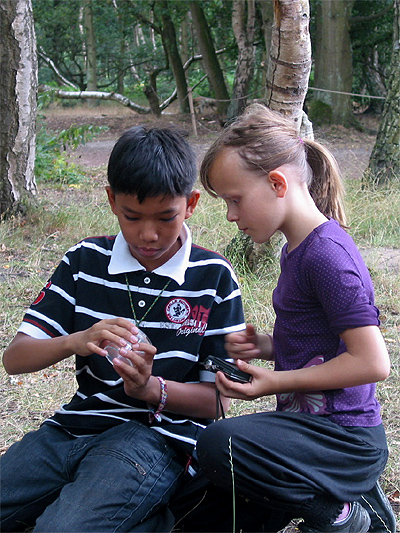 |
|
| ... | ||
|
Moths are wonderful there's no doubt about
that, but having 2,500 odd species in the UK suddenly makes them seem
just a little too formidable a task to take up on your own. Even if you
ignore the micros, there's still a very large number of macro moths to
sort out and learn, but it is possible but so much easier with some
help, which is where we come into this. A number of years ago Dilys and myself were doing a public moth trapping event at the old Sherwood Forest Visitor Centre. It was poorly timed in all honesty but was booked weeks in advance, coincided with a full moon, clear skies, cold temperatures and (I think) a grand total of two Small Quakers. But the evening was a success for us, this website and the three representatives of the then Lound Moth Group who attended the event. |
||
| .. | ||
| Male Dahlica inconspicuella (dorsal view) | .. | ... |
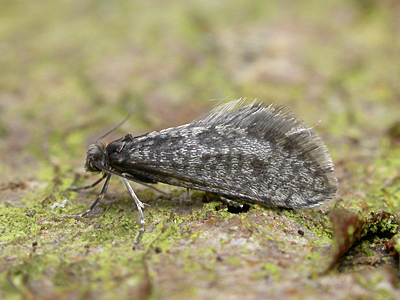 |
Phil Cadman, Ian Hunt and Martin Warne were
new to moths and looking for help. Even now, Phil would jokingly say
that they still are, but over the years they have learned much about
moth identification and we somehow helped them along the way. I just
wish I could have my hair back! The website benefitted from their enthusiasm and willingness to bring the fantastic moths they trapped at the Idle Valley Nature Reserve - an act which in the end benefitted everybody with an interest in moths - especially Nottinghamshire moths. We got the photographs and Phil, Ian and Martin got identifications for those species they couldn't put a name to. Then came the Covid-19 lockdown and so Phil began recording from home with increased regularity. Again, a number of rare county moths turned up and we again got photographs and Phil got his unidentified moths prompty identified. But as with any other invertebrate Order, anything with wings has the ability to turn up anywhere and this can even be in the most unlikely of places. And include spiders in on this, as they can 'balloon' many miles without so much as lifting a leg and literally end up on your doorstep. |
|
| ... | ||
| But the 'darker side' of entomology (moths) is strewn with rewards, especially if you are willing to put in a degree of effort. And to be honest, a Worksop kitchen is one of those 'unlikely' places. Who would ever expect to find a county first while making a cup of tea? But it happened in the opening flourish of 2021, when Phil found a small moth on his kitchen wall on February 27th 2021. | ||
| .... | ||
| ... | . | Male Bankesia conspurcatella (lateral view) |
|
A surprising county first He quickly potted it up and identified it as a possible Dahlica inconspicuella (Stainton, 1849). Phil emailed a couple of photographs over to me and I initialy agreed that Phil's identification was sound, but then a nagging element of doubt started to creep in. Dahlica inconspicuella did seem the most likely species based on the photographs, but knowing the restricted Nottinghamshire range of D. inconspicuella and in view of the suburban location of the Worksop record, I suspected that it could actually be Bankesia conspurcatella (Zeller, 1850) largely based on recalling reading somewhere that B. conspurcatella had turned up in urban Cardiff back in 2005 and had subsequently been recorded in the north-west. I talked with Phil and suggested he brought the moth over to photograph, before considering getting the identification checked to be certain. On seeing the moth 'in hand' so to speak, I started to become more convinced that it was indeed Bankesia conspurcatella. |
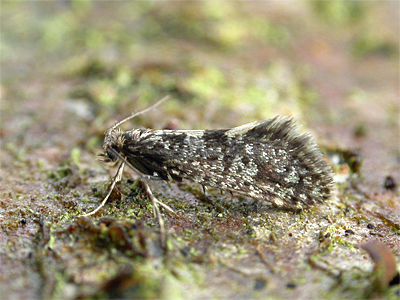 |
|
| .... |
| But as my suspicion was based purely on seeing a number of Dahlica inconspicuella males, it was felt important we got it checked. So after photographing the moth and checking images against those on the internet, now firmly believing Bankesia conspurcatella to be the more likely ID, I contacted Martin Gray (the Lincolnshire micro moth recorder) and handed the moth over to him the next day. Martin was wonderfully quick with the gen det results and confirmed that the moth was indeed Bankesia conspurcatella. |
| .... |
| Male Dahlica inconspicuella (dorsal view) | . | Male Bankesia conspurcatella (dorsal view) |
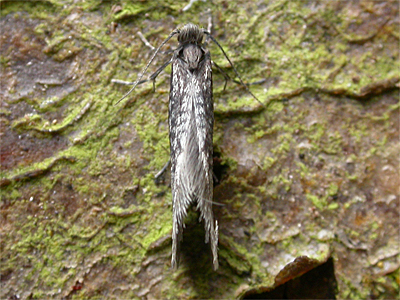 |
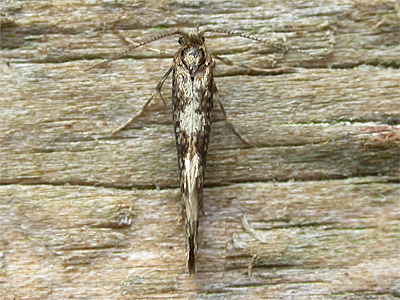 |
| ... |
|
A visual comparison of species Some UK websites mention that for a number of years, there has been discussion amongst various authors as to the identity of Bankesia conspurcatella. It was formerly known as Bankesia douglasii sensu auctt. nec (Stainton, 1854) and before that Taleporia conspurcatella (Zeller, 1850) but at the time of writing is known as Bankesia conspurcatella (Zeller, 1850). Whilst I personally feel that there is a distinct difference in forewing colour between species, this may not be enough to confirm the record with most county recorders. Dahlica inconspicuella males have a rather plain dull (almost leaden) grey background colour to the forewings, with a series of darker markings that consist of three prominent blotches, with numerous short fainter streaks. |
||
| ... | ||
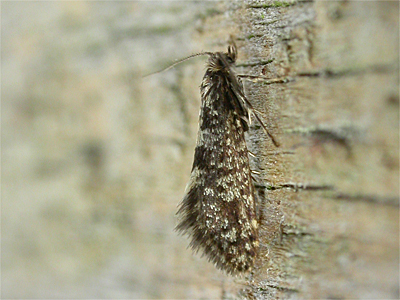 |
The forewings of Bankesia conspurcatella are similar, but
the colouration feels warmer, with an overall brownish tone. The
markings are more distinct, being more obvious and contrasting when the
moth is viewed from above. But the main difference is in the antennae,
with the antennae of conspurcatella being slightly pectinate.
UK distribution and range So Nottinghamshire sudndenly had a new moth and it wasn't even March. It meant a wonderful start to 2021 and just reward for the finder's continued efforts. A few days later while undertaking some background research before working on this page, I discovered on the Norfolk Moths website that Bankesia conspurcatella had also been recorded new to Norfolk at North Elmham VC28 (Appleton, D.) on 22/02/21. This was less than a week before the Worksop record. Clearly Bankesia conspurcatella is somewhat under recorded across the UK, although undoubtedly still an uncommon, or even rare species. There are known records from Hampshire in 1984, Kent and Yorkshire in 1985 and Cardiff 2005. |
|
| Moths |
| Insects |
| Homepage |
| Contents |